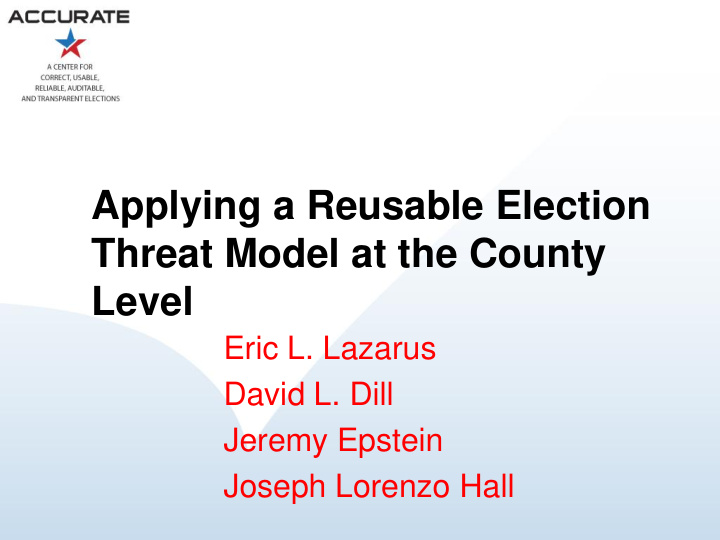



Applying a Reusable Election Threat Model at the County Level Eric L. Lazarus David L. Dill Jeremy Epstein Joseph Lorenzo Hall
Motivation Legitimacy of government depends on trustworthy elections. Potential for undetected fraud undermines the basis for trust. Elections are extremely attractive targets for fraud. Attackers may be highly motivated. And have access to massive resources. Primary responsibility for fraud prevention/detection rests on local election officials.
Scope Focused on attempts to steal election without detection. Injecting fraudulent ballots into system. Changing results after ballots are cast. Did not consider “Robbery in broad daylight”. Mistakes, breakdowns, etc. Deniable but detected attacks. Vote suppression. Misleading campaigns. Sabotage of campaigns. Etc.
Importance of procedures Even the best election technology cannot prevent fraud. Optimal procedures are crucial. Physical security of ballots. Auditing (broadly construed). Public observation (to deter insider attacks). Achieving an acceptable level of security is highly nontrivial.
Systematic Threat Evaluation Election security is a tough, complex problem. How should scarce resources be allocated? Need quantitative comparison of threats and countermeasures. Which threats to address first? At what price? Also helps with larger policy debates (e.g., electronic/internet voting). But how can we do it?
Proposed solution Systematic, quantitative threat modeling at the local level. Based on (generalized) attack trees (AttackDog tool). Major challenge: How to make it feasible? Solution: Tailor a generic, reusable threat model to the particular jurisdiction. We tested this idea in Marin County, CA, in the November 2010 general election.
Marin County, CA Medium-size county (pop. 242,409) just North of San Francisco (across Golden Gate Bridge). With very patient and helpful election officials (esp. Elaine Ginnold – THANKS!) Uses precinct-count optical scan voting + central count optical scan. Lazarus and Hall Interviewed staff. Observed on Election Day. Observed post-election hand audits.
Threat evaluation methodology <Figure out how to explain AttackDog concisely> Picture of attack tree, with key concepts? Goals, and/or nodes, attack steps Attacks, attributes, attack cost. Reusable parameterizable subtrees. “Omit” nodes. Defense domain. Computing attack cost COST CAN BE ANYTHING. Distinguish CAPABILITIES from APPLICATION in this case.
Attack Team Size (ATS) Metric for attack team cost. ATS = number of people knowingly involved in the election fraud. Justifications Major consideration: risk of detection. May thwart goal. May incur penalties. Relatively simple (minimizes number of “judgement calls”). Not misleadingly precise.
Reusable threat model Began with very detailed general threat model. Developed over several years. Learned from Leon County, FL Incorporated aspects of EAC model (TIRA) (Yasinsac). Learn jurisdiction-specific details Focus on critical aspects, based on existing tree and knowledge (e.g, auditing, physical security). Observe procedures in practice. Polling place procedures. Ballot transportation and storage. Auditing procedures. Set parameters appropriately Change model (hopefully, not much).
Model adaptations for Marin Parameters Estimated # of voters, polling places. # of poll workers/polling place. # of members of each ballot counting team during manual audit. Qualitative parameters (stringency of tamper evidence measures and audit procedures). Election assumptions: Margin of victory, # of votes that can be stolen in a precinct or machine without being obvious.
Model extension Ballots are transported from polling places to election office in two stages: Poll workers take ballot boxes to “drop -off centers”. Many boxes are loaded into trucks for transportation to final destination. This has an impact on ATS, because small teams have access to many ballots during the second stage of transportation.
Computer security is useless* There are infinitely many ways to subvert computer systems with ATS = 1. Securing machines is hopeless (from this perspective). Only hope for increasing ATS is to used audited “software independent” systems. (We did not evaluate computer security in Marin.) *for increasing ATS
Malware attack Subvert voting technology Make voting machines cheat using malware. Steps: Write malware, insert malware, evade testing, etc. Must also defeat California manual auditing process of paper ballots. Tamper with paper ballots during transportation or storage. Insider attacks on audit process. Non-random precinct choice. Defeat comparison of hand count with committed total.
Vote by mail attacks Obvious: Election office insiders could discard ballots (1 insider). Less obvious: “Stolen registration” attack Small number of attackers registers many legal but never-registered voters (1 insider at Dep’t. of Moter Vehicles has this info). Requests absentee ballots be sent to various addresses. Small team fills out many ballots and mails them in.
Weighted attack team size Alternative metric: Insiders are “more costly” than outsiders on attack team. Rationale: Insiders are harder to recruit, may be more carefully vetted. We tried: 1 insider = 10 outsiders (easy in AttackDog). Shifts low-cost attacks to outsiders Subverting audited ballots – 2 outsiders. Discarding VbM ballots – 10 (1 insider). VbM “registration theft” – 8 outsiders.
Discussion Threat evaluation with reusable threat models may be practical. Even with paper ballot systems and audit requirements, security is tough. Physical security of ballots. Auditing is very sensitive to procedural details. This study is a first step, not a solution.
Future Tool improvements More efficient evaluation under multiple scenarios. Better summarization of possible attacks. General “productization” Make the problem simpler Simplified elections. Standardized security for election jurisdictions. Individual ballot auditing.
Who should do evaluations Independent experts using standard threat models evaluating standard procedures
Recommend
More recommend